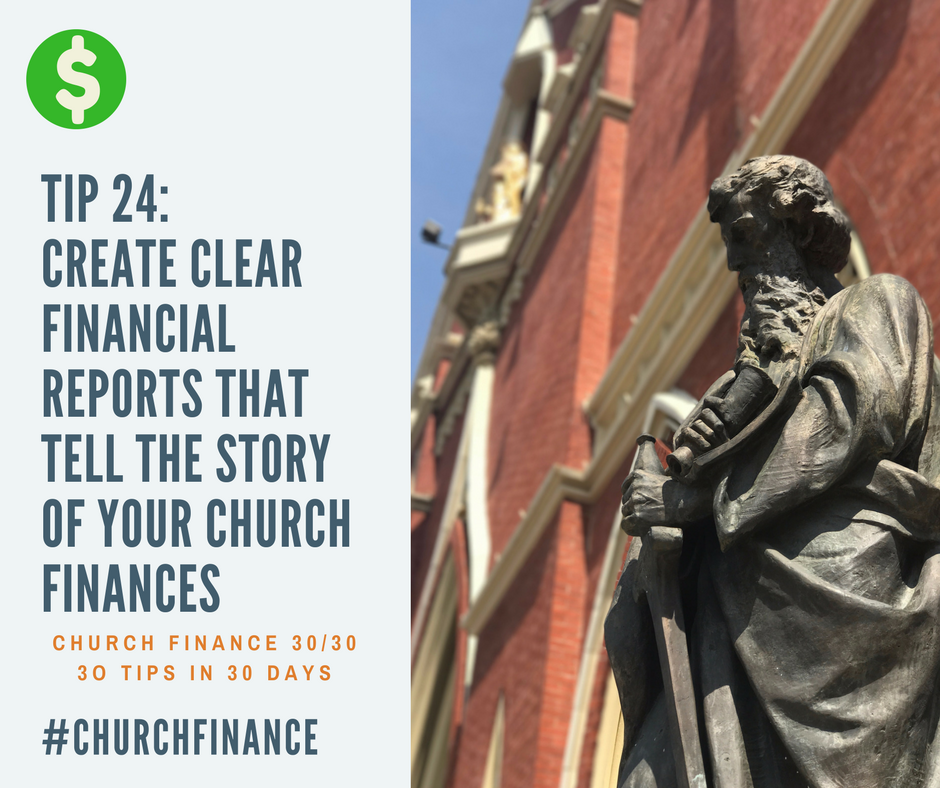Does your church struggle with creating clear, understandable and transparent church finance reports? If so, you are not alone!
As churches balance the broad range of financial information that parishioners seek, they also struggle with what to report and how to communicate this information. Many churches offer financial reports that are inaccessible or downright confusing, while others report results in such a basic fashion that the data does not lead to any clear insights.
Even though studies show that communicating financial information to parishioners has a positive impact on stewardship and involvement, many churches either fail to see the linkages or become paralyzed by the options. Sadly, beyond the reporting of the end-of-year financial statements, a significant number of churches choose not to report any financial information.
A substantive church financial report will both engage and empower parishioners to understand their parish finances. However, creating this type of report can feel overwhelming, so let’s break down the process into manageable components.
Construct the Financial Narrative
Define the Goal and Audience
Two questions are critical as you begin to create any financial report, “What is the goal of the report?” “Who is the audience?” Answers to these questions are essential to help you as you craft the narrative. By understanding the purpose of why you are creating a report, you will have direction as to what you build.
For example, are you offering a high-level overview of revenue and expenses for the prior year? Or, is the report being created for the Finance Council as they help you prepare the annual budget? The answers to these questions will help guide you as to what to include in the report and the level of details that are needed.
What is important in this process is that you include all relevant information to help the audience achieve informed insights. There is a tendency to believe that the term “financial transparency” is defined as “the more information provided, the better the report.” However, this is not true if the information you communicate overwhelms or even distracts the audience from the most critical information. Just because you have extensive data does not mean that you need to include every piece of information in all of your reports!
Tell a Story
Mark Twain said the first rule of writing was “that a tale shall accomplish something and arrive somewhere.” I argue that that the same rule applies to creating financial reports. The best church financial reports have a beginning, middle, and arrive at a conclusion. The structure you can use for your narrative is to start with where the parish is today with finances. Next, offer any context from the past that can help inform the present situation. Finally, conclude the narrative by looking towards the future.
The Present – Where are we today?
Begin the report with a narrative that concisely describes the current state of finances for the parish. Typically, this will include a discussion of overall revenue and expenses compared to budget targets. For many churches, more than 80% of income comes from collections. Therefore, offer a status on Sunday offerings, donations, and discuss any changes in program income.
In the narrative, include a discussion of expenses. Were there any significant outliers? For example, did a massive snowstorm cause maintenance costs to soar? The narrative can also describe updates on staff changes, capital projects, debt obligations/payments, endowment/savings accounts, policy changes, and/or any programmatic updates.
The Past – Where have we been?
In the next section of the narrative, discuss how the financial situation today relates to the history of the parish’s finances? For example, if collections are lower than anticipated, consider any previous cases when this has occurred. Visuals in this section can be particularly useful to offer additional context or convey complex financial information.
The Future – How are we leading into future?
Conclude the report with a discussion of the future. Consider answering questions that may include, “What are the areas of growth at our parish?” “What is the plan for addressing any challenges in the future?” “What areas are we most grateful?” “Where do we see our future as a parish community?”
For example, if there has been a surge in parishioner registrations, discuss the opportunities. If a new staff member has been hired to work on a particular program, discuss excitement for parishioners to get involved. If new policies are being implemented to address a financial situation, write about what actions are being taken to deal with what has happened.
How do I find out more information?
At the end of the report, provide a point of contact (POC) with name, phone number, and email to address comments, questions, or concerns. If readers seek further information, they will have a POC that can offer additional details.
Read More Church Finance 30/30 Tips
Excerpt from my original article in the Villanova University Center for Church Management and Business Ethics Newsletter, “Communicate Church Financial Information with Impact and Ease” (Spring 2017).

